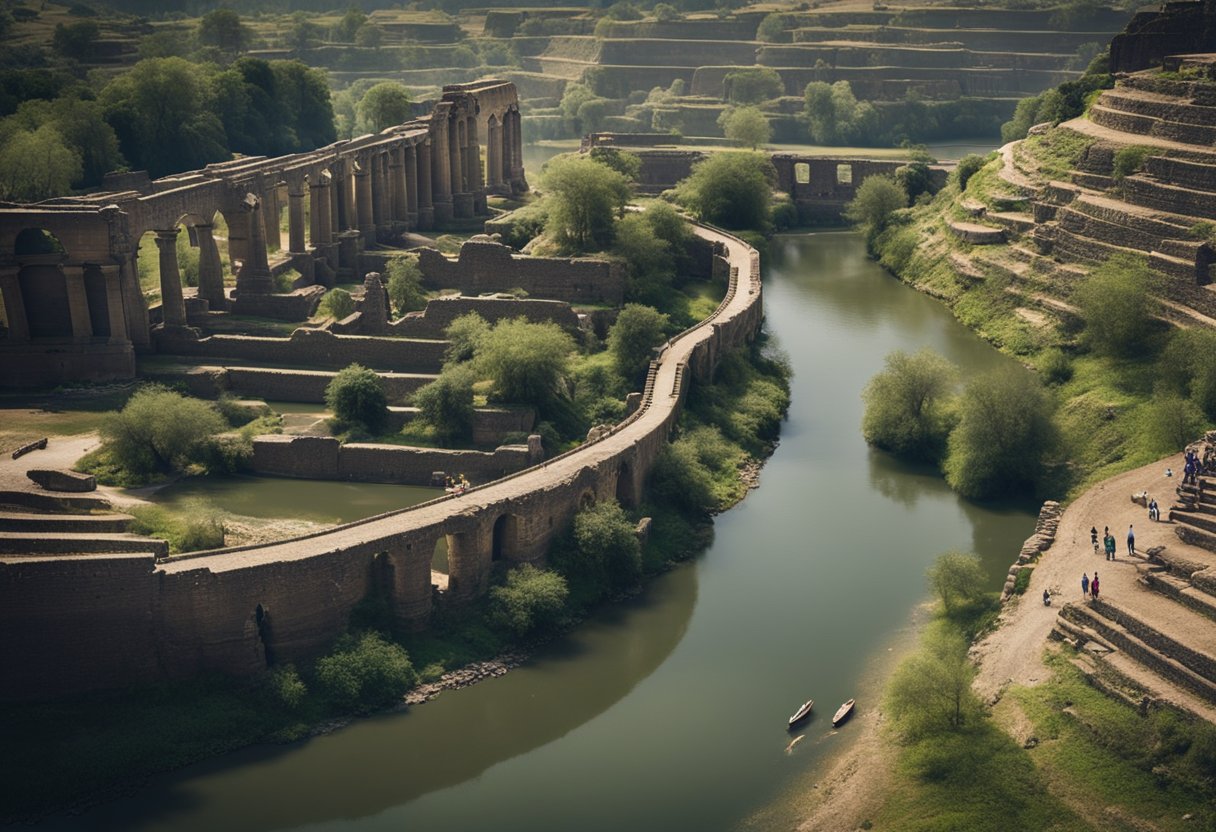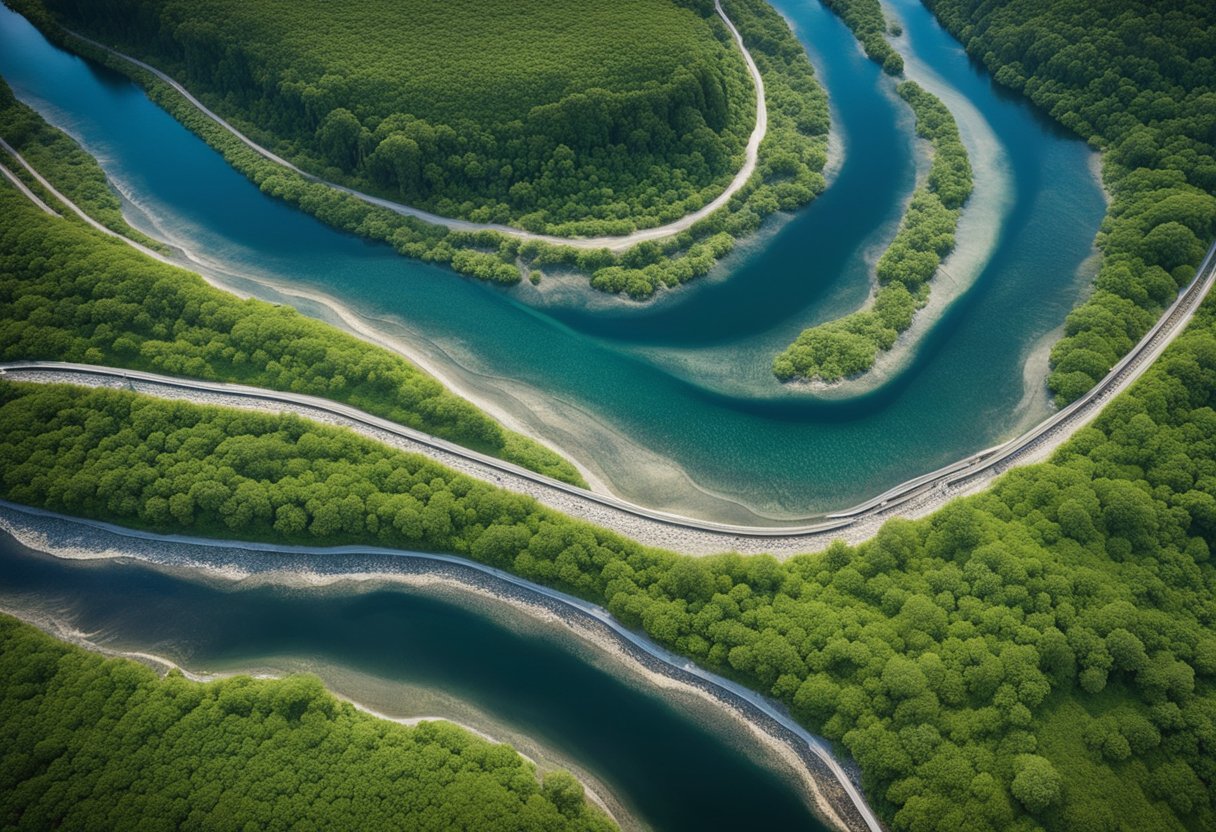The Cultural Significance of Rivers: Tracing the Veins of Human History

Updated On: April 17, 2024 by Raghda Elsabbagh
Waterways have held a cradle in the palms of their banks, nurturing civilisations with sustenance, travel, and trade. Rivers have been pivotal to the development of societies around the world, providing vital resources for agriculture, shaping landscapes, and offering pathways for commerce and communication. From the Thames to the Yangtze, these rushing lifelines have facilitated the burgeoning of cultural hotspots, fostering environments ripe for human ingenuity and communal growth.

Our histories are deeply entwined with these meandering streams, where each river tells a story of human endeavour and ecological change. The presence of rivers has often influenced spiritual practices, artistic inspirations, and technological advancements. The cultural significance of rivers is reflected in the way we’ve interacted with these watercourses, shaping our ways of life, traditions, and collective resilience against environmental challenges. As societies evolve, the conservation and ethical management of rivers remains imperative to maintaining the essence of our shared heritage.
Table of Contents
Rivers as Cradles of Civilisations
Rivers have been pivotal in the birth and growth of civilisations throughout human history, serving as a source of water, a means for agriculture and trade, and a catalyst for the development of cities.
Early Settlements and Societies
Ancient civilisations often sprang up around rivers, which provided a reliable water source and fertile land for cultivation. For instance, the Indus River Valley saw the emergence of flourishing societies. Similarly, the banks of the Nile in Egypt and the Tigris and Euphrates in Mesopotamia became the seats of complex urban centres. These rivers played a central role in shaping the cultures that thrived alongside them.
Agriculture and Irrigation Systems
The growth of agriculture was heavily dependent on rivers. The predictability of the Nile’s flooding, for example, allowed Egyptian civilisation to develop sophisticated irrigation systems. In China and India, rivers also supported the spread of agriculture, which led to increased food production and, subsequently, population growth and urbanisation.
Trading and Economic Networks
Rivers were the economic arteries between ancient cities, facilitating the exchange of goods, ideas, and culture. The Nile served as a trade superhighway linking Egypt with other parts of Africa and the Mediterranean, while the dense network of trade routes along the Indus played a similar role in the Indian subcontinent. These waterways enabled trade and interaction among different civilisations, enriching the cultures and economies of the societies along their banks.
Cultural and Spiritual Significance of Rivers
Rivers have shaped our cultures, beliefs, and societies, serving as a backdrop to numerous spiritual narratives and artistic expressions. They are integral to many ceremonial practices and continue to influence our lives through traditions and festivals.
Mythology and Religion
Mythology and religion are deeply intertwined with rivers. The Nile River, for example, is central to Egyptian mythology, associated with the god Hapi, who symbolised fertility and abundance. Rivers are often deemed sacred in various religions, serving as the setting for rituals like baptisms and funerary rites. The link between these waterways and religious beliefs underscores their perpetual reverence in human culture.
Arts and Recreation
Rivers have long been a muse for art. Our collective heritage is rich with descriptions of rivers in language and writing, while dance and music often emulate the flow of water. Recreationally, rivers are venues for activities like boating and fishing, which not only entertain but also foster a connection to nature that echoes through our artworks and leisure practices.
Social Customs and Festivals
Rivers play a pivotal role in social customs and festivals. They serve as gathering places for communal events and times of celebration, such as the Loy Krathong Festival in Thailand, where rivers glitter with candle-lit offerings. Such festivals not only bring communities together but also pay homage to the life-giving nature of these waterways, intertwining tradition with thanksgiving and cultural identity.
Environmental Dynamics and Human Impact
Rivers, the cradles of human civilisation, continue to shape and be shaped by our interactions. This section explores the profound impact of human activities on river environments, addressing the intricate balance between ecological needs and human demands.
Ecology and Biodiversity
Rivers are bastions of biodiversity, supporting an array of species that are intricately linked to their ecological health. Alterations to river systems, whether through dam construction or pollution, can disrupt the delicate balance of these ecosystems. The introduction of non-native species for purposes like fishing often leads to unforeseen consequences, threatening native species’ survival and affecting the broader ecological network.
Climate Change and River Health
Climate change poses a significant risk to river health, leading to altered flow regimes, increased salinisation, and more frequent extreme weather events. These changes not only affect the physical characteristics of rivers but also the species that rely on them, including us. Studies highlight the necessity for environmental flow assessments to maintain the balance between ecological and human water needs.
Water Crisis and Resource Management
The competition for water resources intensifies as human populations grow and climates alter. Effective water management institutions are essential in ensuring the equitable distribution of water and in promoting sustainable use practices to prevent crises. Furthermore, measures against salinisation and pollution are pivotal to protecting both human interests and environmental health. Strategies in environmental water management need to be informed by a deep understanding of river systems to achieve long-term sustainability and resilience.
Innovations in River Technology

We’ve witnessed remarkable progress in the river technology domain. These developments have been pivotal in enhancing water management, improving transportation, and safeguarding environments.
Hydraulic Engineering
Hydraulic engineering has been the cornerstone of river management. Our focus on hydraulic systems has led to sophisticated designs in dam construction and canal systems. These structures are crucial in flood control, irrigation, and generating hydropower. Emphasising the balance between construction and environmental flow ensures the sustainability of river ecosystems.
Water Management Advances
Advances in water technology and governance systems have transformed how we manage our precious water resources. The establishment of advanced filtration and wastewater treatment plants exemplifies our capacity to maintain clean water supplies. On a governance level, policies centring on integrated water resource management strive to align human and environmental water needs.
Remote Sensing and Data Collection
The integration of remote sensing into river management has revolutionised our ability to collect and analyse data. Utilising satellite imagery and geographic information systems (GIS), we now monitor river basins extensively, gaining insights into water quality, usage patterns, and potential flood risks. These technologies aid in making informed decisions about river conservation and management.
By continually embracing these innovations in river technology, we enhance our ability to nurture and protect the lifelines of our civilisations.
The Role of Rivers in Agriculture
Rivers have been central to the development of agriculture, providing water for irrigation, enabling crop diversification, and facilitating trade through navigable waters. Their influence has shaped agricultural systems and practices across various civilisations.
Irrigation and Farming Techniques
We recognise that irrigation serves as the backbone of farming, particularly in regions where rainfall is unpredictable. History shows us that ancient civilisations, such as those in Egypt and Mesopotamia, developed sophisticated irrigation methods to draw water from rivers, ensuring a consistent water supply for agriculture. These hydraulic societies constructed canals, dikes, and weirs, harnessing the natural flow of rivers to nourish their farming lands.
Crop Domestication and Trade Growth
Rivers have facilitated crop domestication, which in turn catalysed the expansion of trade. As agricultural systems evolved, surplus produce from fertile river valleys like the Nile and Indus led to trade with neighbouring regions. The growth of trade along rivers not only facilitated the barter of crops but also the exchange of valuable materials like tin, lead, and bronze, which were instrumental in advancing agricultural tools.
Animal Husbandry and Aquatic Resources
In addition to crops, rivers provide essential aquatic resources for animal husbandry. Watering livestock and utilising rivers as a food source through fishing practices have been integral to agricultural productivity. Furthermore, rivers enriched with minerals have supported the health of both livestock and humans, contributing to the overall sustainability of agricultural communities.
Riverine Societies and Urban Development
Rivers have been vital to the growth and sustenance of civilisations throughout history. They’ve moulded settlement patterns, boosted commerce, and influenced the urban landscapes within which cities thrive.
Settlement Patterns Along Rivers
Historically, rivers like the Nile in Egypt and the Ganges in India have provided fertile soil for agriculture due to annual flooding, enabling the establishment of stable communities. The Himalayan rivers, for instance, have been pivotal in supporting agriculture, which in turn has led to the growth of towns and cities along their banks.
Expansion of Trade Centres and Ports
Rivers have often given rise to bustling commerce hubs. Cities like Varanasi on the Ganges or Cairo by the Nile evolved into significant economic centres due to their strategic locations. These cities benefited from the trade in goods such as spices and silk, with ports on rivers like the Euphrates becoming linchpins in trade routes.
Impact on Urban Landscapes
Urban landscapes have been shaped by the presence of rivers, providing water for both industrial and domestic use. The Yellow River’s influence on Chinese civilisations is a case in point, with numerous cities having been built in its basin. These urban areas have adapted to the natural course of rivers, which have, in turn, been modified through canal building and other engineering works to support urban life.
Artistic Expressions and River Culture
Rivers have long inspired art, shaping culture and heritage through various forms of expression, from writing to the visual arts. They act as muses in the creation of work that defines and communicates the intrinsic value of our traditions and languages.
Influence on Literature and Language
Rivers have woven their way into literature and have, as a result, enriched language with metaphors and symbolism. They are the backdrops for epic narratives and poetry, where the flowing waters mirror the trials and tribulations of life itself. The Mississippi River is famously immortalised in Mark Twain’s books, capturing the essence of 19th-century American life. Likewise, the Thames in England serves as the central artery in Charles Dickens’ narratives, providing social commentary on Victorian society.
Visual Arts and Architectural Evolution
The banks of rivers have served as the foundation for cultural heritage in the form of grand monuments and cities. Riverscapes dominate the canvases of artists, with works such as Monet’s Water Lilies capturing the tranquil essence of the Seine. Architecture too, has been influenced by the presence of rivers, from the awe-inspiring Ghats of Varanasi to the elegant bridges that span Europe’s mighty Danube. These structures not only symbolise connectivity but also showcase the ingenuity and creativity inherent in riverine societies.
Music and Dance Traditions
Traditions of music and dance have flourished alongside rivers, often celebrating the elemental connection between water and life. The Danube, for instance, has been celebrated in waltz form by Johann Strauss II, encapsulating both the vitality and the romance of the river. African river communities have long used the rhythm of the river as a backdrop for spiritual dance rituals that pass from generation to generation, preserving the unique identities of cultural groups.
Water and Societal Resilience
In the face of environmental changes and water crises, communities and cultures demonstrate a remarkable ability to adapt, ensuring their survival and continuity. The resilience of these societies is often rooted in their relationship with rivers and other bodies of water, which have remained central to cultural diversity and environmental water management.
Adaptations to Environmental Changes
Historically, civilisations have developed complex systems to manage water resources, enabling them to weather environmental changes and maintain their resilience. For example, ancient societies constructed expansive irrigation networks, such as those seen in the Indus Valley, which were crucial for agricultural success amidst fluctuating weather patterns. Today, contemporary cultures continue to refine these systems, incorporating technology and historical knowledge to safeguard water supplies, a vital measure against the increasing volatility in climate.
River Restoration and Conservation Efforts
Conservation efforts are essential to the health of rivers, reflecting a profound understanding of nature’s delicate balance. Programmes like those in the Everglades focus on restoring the natural flow of water, benefiting both the environment and the human communities that rely on these ecosystems. It is through such dedicated efforts that vital waterways, once diminished, are given new life—ensuring cultural traditions linked to them endure for future generations.
Institutions and Governance
Effective systems of governance are crucial to managing and distributing water resources in a way that supports societal resilience. Institutions often embody the collective will to confront challenges and ensure sustainable environmental water management. In regions where water scarcity poses a serious threat, multinational agreements are forged for equitable distribution and usage, demonstrating a shared commitment to overcoming adversity through cooperation and governance.
Decline and Preservation of River Ethos
As rivers face challenges from ecological degradation to diminished cultural roles, we’re tasked with preserving the rich heritage that water bodies represent.
Historical Contamination and Present Challenges
Historically, rivers have endured significant contamination from industrial effluents to urban waste, leading to a decline in their health and that of the surrounding ecosystems. The modern challenges we face range from chemical pollution to the physical alteration of river courses, which disrupts both human-flow relationships and the existence of riverine communities reliant on these water systems. Ensuring ecologically ripe conditions for rivers is imperative not only for the environment but for the sustenance of traditions and the well-being of indigenous peoples.
Safeguarding Cultural Water Requirements
The cultural water requirements of communities form an essential element in the mosaic of river ethos. Preserving such requirements goes beyond ecology; it’s about respecting indigenous rights and inherited wisdom. Integrating local knowledge with scientific approaches aids in sustaining the cultural significance of rivers, ensuring that they continue to serve not just as physical entities but as symbols of life and continuity.
Heritage and Modernity Balance
In our quest to balance heritage and modernity, it’s vital that we maintain a synergy between the need for development and the importance of preserving our environmental and cultural legacies. Through initiatives like responsible tourism and community-led conservation efforts, we aim to foster an environment where traditions can coexist with contemporary practices, allowing riverine communities to thrive while keeping their connection to the river intact. Understanding the intricate human-flow relationships paves the way for a future where both the river’s ecological integrity and its cultural significance are upheld.
Global Rivers and Cultural Interconnections

Rivers have served as crucial conduits for cultural exchange and the development of civilisations. They’ve not only sustained populations but also connected disparate cultures.
Comparative Studies of World River Systems
When we examine river systems like the Nile, Tigris, Euphrates, and the Huang He, similarities in their cultural impacts become evident. Ancient riverine societies such as those in Mesopotamia and Egypt developed intricate systems of irrigation, fostering agricultural prosperity and stable communities. This, in turn, supported the development of significant cultural and technological advancements. For instance, our understanding of the Indus and Saraswati rivers reveals that water bodies in Central Asia were pivotal in shaping the South Asian civilisations along their banks.
Role in Shaping International Relations
Rivers often form natural boundaries and have influenced political borders throughout history. The Rhine in Central and Western Europe, for example, has been a delineating line for territories and a trade artery that facilitated economic interdependence among bordering nations. The sharing of the Nile waters continues to play a critical role in the international relations between Northeast African countries. It’s imperative that these relationships are managed with mutual understanding and cooperation to ensure equitable use of these vital water resources.
Exchange of Ideas and Cultural Merging
The bustling banks of the Ganga (Ganges) in India and the Yangzi in China have been historic hotspots of human activity, witnessing unprecedented exchange of ideas, beliefs, and innovations. These rivers have been arterial routes enabling the flow of goods, philosophies and artistic expressions, which have often led to the merging of cultures. The Mediterranean, fed by many such rivers, was central to the interchange that gave rise to some of the most enduring civilisational dialogues between Africa, Asia, and Europe.
Conclusion
Rivers have consistently shaped our cultural landscapes, serving not only as physical demarcations across continents but also as vessels of civilisation. They are inseparable from the cultural heritage that has flourished on their banks. Across the globe, from the sacred Ganges to the historic Thames, rivers have nurtured societies, enabled prosperity, and inspired countless works of art, literature, and spirituality.
Our studies in the social sciences reaffirm that rivers are more than mere bodies of water—they are cultural artefacts intimately woven into the fabric of human existence. They have been the centrepiece in the rise and continuity of civilisations, influencing settlement patterns, trade, and even the outcome of battles. Through the millennia, rivers have defined and redefined borders, supported agricultural endeavours, and have been the source of countless innovations.
We acknowledge that preserving the natural state of rivers is essential to maintaining the cultural and historical narratives they hold. It is vital for our generation to recognise their worth beyond the utilitarian—to understand that rivers are living archives of our shared human experience.
In safeguarding these natural waterways, we are not only protecting the environment but also our collective memory and identity. Rivers are the lifeblood of human heritage, and as we continue to explore and define their cultural significance, their conservation becomes not just an ecological responsibility but a pledge to our own cultural continuity.
Frequently Asked Questions
Rivers have been the cradle of civilisation, providing essential resources for survival, development, and cultural evolution. They have shaped societies in profound ways, influencing everything from agriculture to religious practices.
Why were rivers central to the development of early civilisations?
Rivers offered a reliable supply of fresh water for drinking, farming, and cleaning, which made them ideal sites for settlements. Proximity to a river ensured that early civilisations like those mentioned on Lumen Learning could sustain themselves and grow.
In what ways did river valleys shape the inception and growth of civilisations?
Fertile river valleys supported the growth of crops, which led to agricultural surpluses and, consequently, the development of societies. As detailed by Geoaffairs, this abundance allowed for the establishment of trade networks, the accumulation of wealth, and the rise of complex social structures.
What role did the flooding of rivers play in the agricultural practices of ancient civilisations?
Floods deposited nutrient-rich silt on the surrounding lands, replenishing the soil and making it fertile. This natural fertilisation process was crucial for sustaining and enhancing agricultural productivity, as discussed in History Hatch.
How have rivers influenced the cultural practices and societal structures of ancient communities?
Rivers have been revered as sacred in many cultures and have influenced religious practices, myths, and legends. As explored in Oxford Bibliographies, they served as a focal point for social activities and ceremonies, thus weaving themselves into the fabric of cultural identities.
Can the establishment and flourishing of ancient civilisations be attributed to their proximity to rivers?
Yes, the establishment of urban centres along rivers was critical for the flourishing of empires. The waterways provided not only life-sustaining resources but also means for transportation and communication, which were essential for expansion and control.
How did the interaction with rivers contribute to the diversity among early civilisations?
Rivers acted as barriers and meeting points, leading to the exchange of ideas, traditions, and technologies. Such interactions, facilitated by river networks, were instrumental in creating a rich tapestry of diverse cultures, as outlined by Springer.






